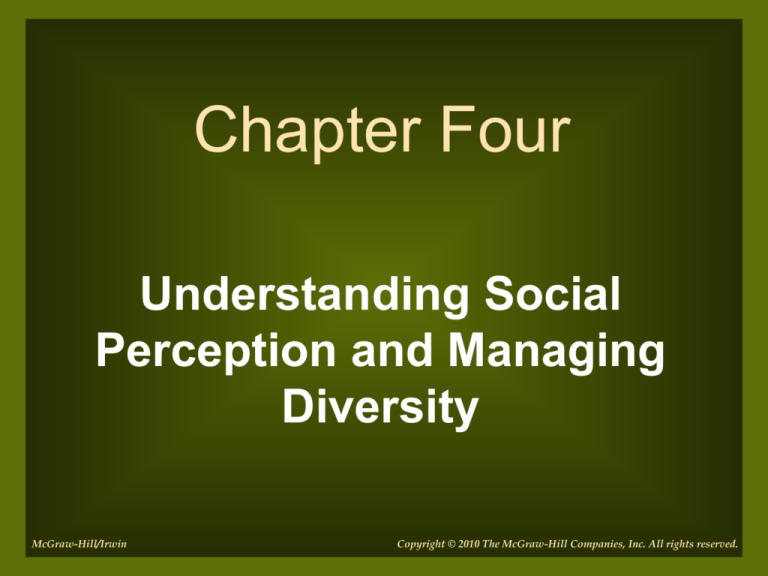
Chapter Four
Understanding Social
Perception and Managing
Diversity
McGraw-Hill/Irwin
Copyright © 2010 The McGraw-Hill Companies, Inc. All rights reserved.
After reading the material in this chapter,
you should be able to:
• Describe perception in terms of the social
information processing model.
• Identify and briefly explain six managerial
implications for social perception.
• Explain, according to Kelley’s model, how
external and internal causal attributions are
formulated.
4-2
After reading the material in this chapter,
you should be able to:
• Demonstrate your familiarity with the
demographic trends that are creating an
increasingly diverse workforce.
• Identify the barriers and challenges to
managing diversity.
• Discuss organizational practices used to
manage diversity
4-3
A Social Information Processing
Model of Perception
• Perception
- the process of
interpreting one’s
environment.
4-4
Social Perception: A Social
Information Processing Model
Figure 4-1
4-5
Stage 1: Selective
Attention/Comprehension
• Attention
- being consciously aware of
something or someone
People pay attention to salient stimuli
• Salient
- something that stands out from context
4-6
Question?
Beverly has $11,000 for investment. She speaks
with various friends and neighbors to find out
what stocks they have invested in. Beverly can
be described as being on which stage of the
social information processing model?
A. Selective attention; comprehension
B. Encoding
C. Simplification
D. Storage and Retention
4-7
Stage 2: Encoding and Simplification
• Stereotype
- beliefs about the characteristics of a group
• Not always negative
• May or may
not be accurate
4-8
Stereotyping Process
1. Categorize people into groups according
to various criteria
2. Infer that all people within a category
possess the same traits
3. Form expectations of others and interpret
their behavior according to our
stereotypes
4-9
Stereotyping Process
4. Stereotypes are maintained by:
– Overestimating the frequency of stereotypic
behavior exhibited by others
– Incorrectly explaining expected and
unexpected behaviors
– Differentiating minority individuals from
oneself
4-10
Stage 3: Storage and Retention
• Event memory
- information about both specific and general
events
• Semantic memory
- general knowledge about the world, mental
dictionary of concepts
• Person memory
- information about a single individual or groups
of people
4-11
Stage 4: Retrieval and Response
• Decisions are based:
- On the process of drawing on, interpreting,
and integrating categorical information stored
in long-term memory
- Retrieving a summary judgment that was
already made
4-12
Managerial Implications: Hiring
• Interviewers make hiring decisions based
on their impression of how an applicant fits
the perceived requirements of a job
• Inaccurate impressions
in either direction
produce poor hiring
decisions
4-13
Managerial Implications:
Performance Appraisal
• Important for managers to accurately
identify the behavioral characteristics and
results indicative of good performance
• Characteristics serve as the benchmarks
for evaluating employee performance
4-14
Managerial Implications: Leadership
Good leaders exhibit the following
behaviors:
- Assigning specific tasks to group members
- Telling others they had done well
- Setting specific goals for the group
4-15
Managerial Implications: Leadership
• Poor leaders exhibit the following
behaviors:
- Telling others they had performed poorly
- Insisting on having their own way
- Doing things without explaining themselves
4-16
Question?
Which of these is (are) managerial implication(s) of
perception?
A. Interviewers with racist and sexist schemata can
undermine the accuracy and legality of hiring decisions.
B. Faulty schemata about what constitutes good versus
poor performance can lead to inaccurate performance
appraisal, which can erode work motivation,
commitment, and loyalty.
C. Research demonstrates that employees' evaluations of
leader effectiveness are influenced strongly by their
schemata of good and poor leaders.
D. All of these.
4-17
Causal Attributions
• Causal
Attributions
- suspected or
inferred causes of
behavior
4-18
Performance Charts
Figure 4-2
4-19
Kelley’s Model of Attribution
• Internal factors
- personal characteristics that cause behavior
• External behavior
- environmental characteristics that cause
behavior
4-20
Kelley’s Model of Attribution
• Consensus
- involves a comparison of an individual’s
behavior with that of his peers.
• Distinctiveness
- involves comparing a person’s behavior on
one task with the behavior from other tasks.
• Consistency
- determined by judging if the individual’s
performance on a given task is consistent over
4-21
time.
Question?
Francesca has had stable performance and
high quality from one task to another. This
refers to:
A.
B.
C.
D.
Low consensus.
High distinctiveness.
High consensus
Low distinctiveness.
4-22
Attributional Tendencies
• Fundamental attribution bias
- ignoring environment factors that affect
behavior
• Self-serving bias
- taking more personal responsibility for
success than failure
4-23
Managerial Implications
• Managers tend to disproportionately
attribute behavior to internal causes
• An employee’s attributions for his own
performance have dramatic effects on
subsequent motivation, performance, and
self-esteem
4-24
Defining and Managing Diversity
• Diversity
- the host of individual differences that make
people different from and similar to each other
4-25
Four Layers of Diversity
Figure 4-3
4-26
Defining and Managing Diversity
• Affirmative action
- voluntary and involuntary efforts to achieve
equality of opportunity for everyone
• Managing diversity
- creating organizational changes that enable all
people to perform up to their maximum
potential
4-27
Increasing Diversity in the Workforce:
Demographic Trends
• Women and minorities are experiencing a
glass ceiling
• Racial groups are encountering perceived
discrimination
• Mismatch between educational attainment
and occupational requirements
• The workforce is aging
4-28
Increasing Diversity in the Workforce:
Demographic Trends
• Glass ceiling
- invisible barrier
blocking women
and minorities from
top management
positions
4-29
Increasing Diversity in the Workforce:
Demographic Trends
• Underemployment
- the result of taking a job that requires less
education, training, or skills than possessed
by a worker
4-30
Question?
Mary Grace has a degree in nuclear
engineering, but has been unable to find a
job in her field. She is currently working at
the drive-thru at McDonald’s. This is an
example of __________.
A.
B.
C.
D.
Degree inflation
Over-employment
Under-employment
Hyper-employment
4-31
What Organizations Are Doing to
Capture Retiring Workers’ Knowledge
Insert Figure 4.4
4-32
Barriers and Challenges to
Managing Diversity
1.
2.
3.
4.
Inaccurate stereotypes and prejudice
Ethnocentrism
Poor career planning
An unsupportive and hostile working
environment for diverse employees
5. Lack of political savvy on the part of
diverse employees
4-33
Barriers and Challenges to
Managing Diversity
6. Difficulty in balancing career and family issues
7. Fears of reverse discrimination
8. Diversity is not seen as an organizational
priority
9. The need to revamp the organization’s
performance appraisal and reward system
10. Resistance to change
4-34
Question?
Jacques, a French national, is the CEO of French Global
Empire with significant operations in Japan and the
United States. Jacques recently announced that all
employees of the company, no matter which part of the
world they may be in, must learn French and
communicate in French only. Which challenge to diversity
does this represent?
A. Cultural flexibility
B. Polychronic time
C. Cultural relativism
D. Ethnocentrism
4-35
Organizational Practices Used to
Effectively Manage Diversity
• Option 1: Include/Exclude
• Option 2: Deny
• Option 3: Assimilate
• Option 4: Suppress
4-36
Organizational Practices Used to
Effectively Manage Diversity (cont.)
• Option 5: Isolate
• Option 6: Tolerate
• Option 7: Build Relationships
• Option 8: Foster Mutual Adaptation
4-37
Question?
A group of minority employees complained
about alleged discriminatory practices to
their manager. She told them to quit
whining and get back to work. This is the
use of _________ to manage diversity.
A.
B.
C.
D.
Denial
Suppression
Isolation
Building relationships
4-38
Supplemental Slides
• Slides 40-45 contain extra non-text
examples to integrate and enhance
instructor lectures
- Slide 40: Positive Contributory Value of Older
Workers
- Slides 41: How do gender stereotypes affect workrelated decisions?
- Slide 42: Women in Gender-Typed Jobs
- Slide 43: Glass Ceiling
- Slide 44-45: Video discussion slide
4-39
Positive Contributory Value of Older
Workers
• Myth #1: Older workers are not top
learners.
• Myth #2: Older workers are not top
performers
• How to retain older worker human capital
- Flexibility in HR policies
- Attitude Change
- Knowledge Transfer Programs
4-40
How do gender stereotypes affect
work-related decisions?
• Stereotype: Women are more interpersonally savvy
- Women 7 on 9-point scale
- Men 5 on 9-point scale
• Scenario:
- Male applicant for COO job is perceived to be a 5
on a 9-point scale
- Female applicant is perceived to be a 6 on a 9point scale.
• Who is perceived to be more qualified on that
dimension?
4-41
Women in Gender-Typed Jobs
• Bias against women often results in their
competence being denied. But what happens
when their competence is acknowledged?
- Recent research suggests that successful
women in male gender-typed jobs are less
liked, personally derogated
- This social rejection affects promotions,
raises, and other rewards.
4-42
Glass Ceiling
See an article on
“Breaking the Glass
Ceiling” by Wirth
4-43
Video Case: Andre Thornton
• What attributes or experiences help Andre
Thorton in being successful at GPI?
• In what ways can Thorton serve as an example
for all minority individuals?
• Does GPI’s size help or hinder them in serving
the needs of their clients?
• Can you draw correlations between sports and
business? What are they?
4-44
Video Case: Wal-Mart Faces
Discrimination Lawsuit
• How could sex-role stereotypes influence the hiring,
evaluation, and promotion of employees at large retail stores
such as Wal-Mart?
• In what ways could a giant corporation like Wal-Mart, with
5,000-some outlets worldwide, prevent or at least minimize
sex discrimination throughout the organization?
• In Wal-Mart stores, women hold 93% of the cashier jobs, the
lowest wage category. To what extent might the self-fulfilling
prophecy affect female employees’ performance in a
corporation where the lowest-paid jobs are done mostly by
women?
4-45







